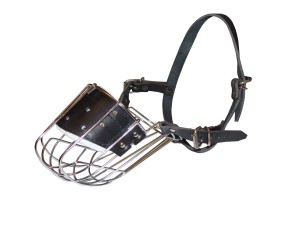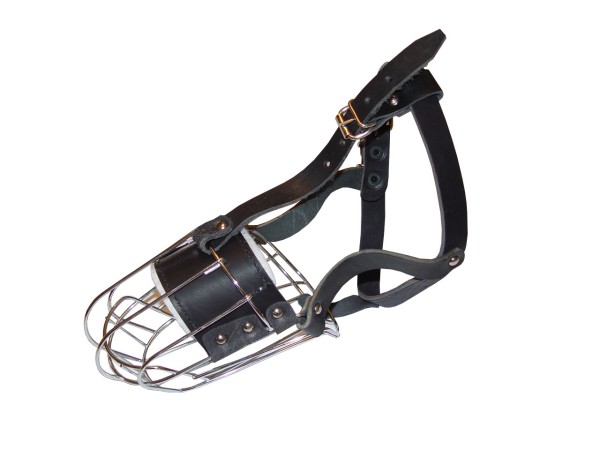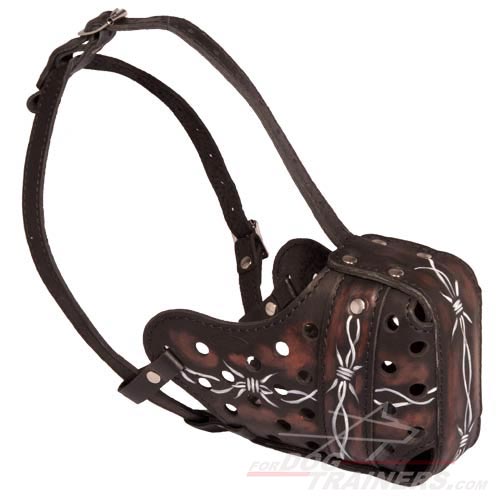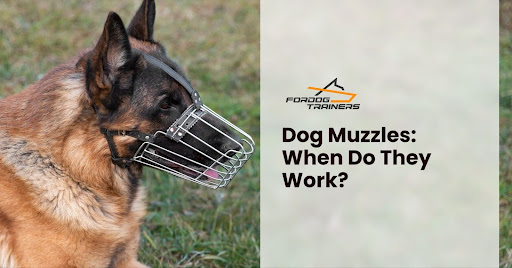When you notice a muzzle on a dog, do you tend to think “there goes a bad dog”? You wouldn’t be alone, but the truth is, the stigma surrounding muzzles is rooted in a lot of misinformation. Muzzles don’t need to be painful or restrictive, and they’re certainly not an indictment of your pup’s good character. In fact, when used properly, muzzles can be incredibly helpful tools for managing certain behaviors and keeping both dogs and people safe.
Contents
Are Muzzles Only for Aggressive Dogs?
Many people associate dog muzzles with aggression, but “aggression” is often an oversimplification or even the wrong word altogether. Muzzles can be useful tools in a variety of situations:
Preventing Biting or Aggressive Behavior
Yes, muzzles can help prevent your dog from biting, especially when they feel scared or threatened. Biting is a natural defense mechanism for dogs, and even the sweetest pup may bite if they feel they have no other option. A muzzle is one way to manage this behavior safely and humanely.
It’s important to note that a muzzle shouldn’t be used as a long-term solution for aggression. If your dog is displaying aggressive behavior, it’s crucial to work with a professional trainer to address the root causes of the aggression. A muzzle can provide safety during this training process, but it’s not a cure-all.
Preventing Scavenging
For dogs who have a tendency to eat unsafe items off the street during walks, muzzles can solve this problem effectively. Scavenging can lead to serious health issues if a dog ingests something toxic or indigestible. A basket muzzle like this one from For Dog Trainers allows your dog to pant, drink, and even take treats while preventing them from picking up any street finds:

Training and Behavior Modification
Muzzles provide a safety net during training, allowing you and your dog to focus on learning new behaviors. They can be especially helpful when your dog is learning to interact with other dogs or people. For example, if your dog gets overexcited and mouthy during play, a muzzle can allow them to engage in play safely while they learn more appropriate play behaviors.
Just remember, a muzzle should never be used as punishment. Putting a muzzle on a dog should always be a positive experience, associated with treats and praise. Using a muzzle as punishment will only create negative associations and could worsen behavioral issues.
During Illnesses, Injuries, and Emergencies
Even the gentlest dogs may bite when they’re in pain or feeling vulnerable due to an injury or illness. In these situations, a muzzle can allow you to transport your dog safely to the vet and allow the vet to examine your dog without risk of bites.
Emergencies like fires or natural disasters can also be highly stressful for dogs. Having your dog wear a muzzle during evacuation can prevent bites that may occur due to fear or confusion. It’s a good idea to get your dog used to wearing a muzzle before an emergency situation arises.
How to Introduce a Muzzle
Properly introducing a muzzle is key to your dog accepting it. The process should be gradual and always paired with positive reinforcement. Here’s a step-by-step guide:
Let your dog sniff the muzzle. Hold the muzzle in your hand and let your dog investigate it. Whenever your dog sniffs the muzzle, praise them and give a treat.
Touch the muzzle to your dog’s face. Hold the muzzle with one hand and a treat with the other. Gently touch the muzzle to your dog’s face, covering their nose for a second, then immediately give them the treat.
Hold the muzzle on your dog’s face for longer periods. Gradually increase the time you hold the muzzle on your dog’s face before giving the treat. If your dog starts to shy away, you’re moving too fast. Go back to a shorter duration.
Fasten the muzzle. Once your dog is comfortable with the muzzle being held on their face, try fastening it for short periods. Start with just a few seconds and work up to longer durations. Always pair the muzzle with treats and praise.
It’s crucial to go at your dog’s pace during this process. If at any point your dog seems uncomfortable, go back to the previous step. The goal is for your dog to associate the muzzle with positive things, not to force them into it
.
Choosing the Right Muzzle
A good dog muzzle should be comfortable, well-fitting, and allow panting, drinking, and treat-taking. There are several types of muzzles available:
Basket Muzzles
Basket muzzles are the most common type for daily use. They’re typically made of plastic or wire and have a basket shape that encases the dog’s mouth. This type allows for panting, drinking, and even treat-taking. For Dog Trainers offers a range of basket muzzles, like this lightweight wire one:

Soft Muzzles
Soft muzzles are usually made of fabric like nylon or mesh. They’re less restrictive than basket muzzles but also less durable. They’re best for short-term use, like a quick vet visit. However, they don’t allow for panting, drinking, or eating, so they shouldn’t be used for extended periods, especially in hot weather.
Leather Muzzles
Leather muzzles are durable and can be quite comfortable for dogs when properly fitted. They often have a more natural look than plastic or wire muzzles. For Dog Trainers has a variety of leather muzzles, including unique decorated ones like this painted design:

When choosing a muzzle, it’s important to measure your dog’s snout to ensure a proper fit. The muzzle should be snug but not tight, and your dog should be able to open their mouth to pant and drink. If the muzzle is too loose, your dog may be able to get it off; if it’s too tight, it could be painful and restrictive.
When Not to Use a Muzzle
While muzzles can be great tools, they’re not appropriate for every situation. Here are a few times when you should not use a muzzle:
As a long-term solution for behavioral issues. If your dog is exhibiting behavioral problems like excessive barking or chewing, a muzzle isn’t the answer. These issues need to be addressed through training and possibly with the help of a professional behaviorist.
For extended periods of time. Muzzles shouldn’t be worn for hours on end. Your dog needs to be able to pant, drink, and eat regularly. Wearing a muzzle for too long can cause discomfort and anxiety.
As a punishment. Never use a muzzle to punish your dog. This will only create negative associations with the muzzle and could worsen behavioral issues.
On a dog that hasn’t been properly introduced to it. Putting a muzzle on a dog that hasn’t been desensitized to it can be highly stressful and may lead to the dog pawing at the muzzle or trying to get it off.
The Bottom Line on Muzzles
Muzzles are tools that, when used properly, can help manage certain behaviors and keep dogs and people safe. They’re not just for aggressive dogs, and using one doesn’t mean your dog is “bad.” With proper introduction and positive reinforcement, most dogs can learn to be comfortable wearing a muzzle.
If you think a muzzle could benefit your dog, talk to your veterinarian or a professional trainer. They can help you choose the right type of muzzle and guide you through the introduction process.
Remember, a muzzle is not a substitute for training and behavior modification. If your dog is exhibiting behavioral issues, it’s important to address the underlying causes of these issues. A muzzle can be a useful tool during this process, but it’s not a solution on its own.
Need help finding the perfect muzzle for your pup? Check out For Dog Trainers’ wide selection for every breed and need:
Shop Dog Muzzles at For Dog Trainers
With the right approach and the right equipment, you can help your dog navigate the world safely and confidently, muzzle and all.

